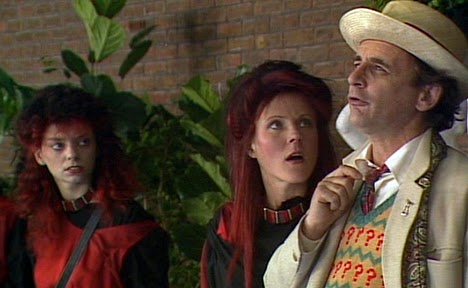DOCTOR WHO, SEASON 24 SERIAL 2:
PARADISE TOWERS
Doctor: Seventh (Sylvester McCoy)
Companion: Mel
February 2024

RED KANGS RED KANGS RED KANGS ARE BEST! RED KANGS RED KANGS RED KANGS ARE BEST!
Paradise Towers seems oddly controversial, and on the one level I get that: it’s growing out of the decidedly bad Sixth Doctor years, and it hasn’t reached the reportedly swanky heights of the later Sylvester McCoy years—I can’t speak to that. I’ve never seen them, I don’t know.
What I do know is that Paradise Towers, even on just one viewing, has immediately landed itself as one of my very favorite Doctor Who stories, because it is so full of ideas and chaos and whimsy that it bulges at the seams.
Paradise Towers owes something to The Web Planet, the way I see it: both stories are bizarre thrill-rides featuring a villainous mind conspiring for control of the setting, and where every character who doesn’t step out of the TARDIS in episode one is alienated to the viewer. In The Web Planet, this was accomplished via actual aliens, the Menoptera, Zarbi, and Optera, with sharp bug-like designs and odd methods of speech and movement. In Paradise Towers, though, everyone is recognizably human (except the not one but two delightfully crappy robot types), and the alienation is entirely pulled off through the way they speak, act, and dress. The Caretakers, Rezzies, and of course the Kangs are all deeply offputting in their every mode of being—even the Rezzies, who look and mostly act like harmless, stereotypical old ladies, are revealed immediately after their introduction to kill and eat the other inhabitants, and the Caretakers are cartoonishly bound to the Rules in the Rulebook.
And I think for a few reasons Paradise Towers succeeds more than The Web Planet does. Firstly, because it is slightly shorter. Secondly, because it uses a rather excellent soundtrack, in contrast with The Web Planet’s astonishing lack of non-diegetic audio. And thirdly, because the set design and colors allow for a garish and shocking setting which, despite being much closer to our world (a luxury set of suites!) is still abysmally far away. Things like the Kangs’ entire design, down to their names and greetings (Bin Liner and Fire Escape, “Build high for happiness!” and “Ice hot!”, even the startling precognizant use of “unalive”), really do sound like the sorts of things a group of youths would end up eventually building a dialect out of, were they trapped in a gigantic high-rise for at least a decade.
Oh, yes, and fourthly, because of Pex. Good old, useless, cowardly Pex. From the moment he crashes through the door the very image of machismo, introduces himself, and is loudly and wearily told to go away, I knew I was going to have fun with this story. Pex’s entire storyline is truly lovely, as is the way his character is treated throughout (the pairing of him with Mel is wonderful), but I especially want to highlight the moment where he snaps off a light and bends it in half to impress Mel, inordinately pleased with himself—and Mel, tired of his antics, tells him that if that trick doesn’t serve any purpose, could he please put the lamp back now, or is he incapable of even doing that? It’s brilliant. The best use of Mel we’ve seen so far, who frankly could have been excellent given the opportunity. She’s great throughout.
Overall thoughts:
It’s great! Go watch it! It’s really, truly lovely. This is cult television, and it is brilliant and beautiful and intensely goofy and contains two different shitty robots. Put it on and enjoy. This is my first time going through the collected Sylvester McCoy years—I definitely like this one more than Time and the Rani—and if this is indicative of the direction we’re headed, then only good things can come.
Build high for happiness!